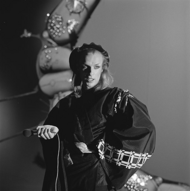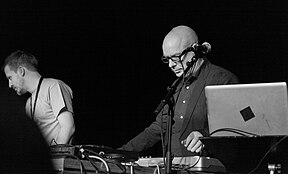Brian Eno
He also established himself as a sought-after producer, working on albums by John Cale, Jon Hassell, Laraaji, Talking Heads, Ultravox, and Devo, as well as the no wave compilation No New York (1978).
In subsequent decades, Eno continued to record solo albums, and produce for other artists, most prominently U2, Coldplay and Peter Gabriel, and including Daniel Lanois, Laurie Anderson, Grace Jones, Slowdive, Karl Hyde, James, Kevin Shields, and Damon Albarn.
[26][27] At Winchester Eno once attended a lecture by future Who guitarist Pete Townshend, also a former student of Ascott's; he cites this as the moment when he realised he could make music without formal training.
[30] This was followed by short stints in multiple avant-garde and college groups, including The Maxwell Demon and Dandelion and The War Damage which featured Eno as frontman who adapted a theatrical persona on stage and later played the guitar.
Initially, Eno did not appear on stage at their live shows, but operated the group's mixing desk at the centre of the concert venue where he had a microphone to sing backup vocals.
After the group secured a record deal, Eno joined them on stage playing the synthesiser and became known for his flamboyant costumes and makeup, partly stealing the spotlight from lead singer Bryan Ferry.
The pair followed their debut with a second album Evening Star (1975), and completed a European tour before splitting due to Fripp isolating himself from the public eye after the disbanding of King Crimson.
Critic Dave Thompson writes that the song is "a near punk attack of riffing guitars and clattering percussion" and that it "could, in other hands, be a heavy metal anthem, albeit one whose lyrical content would tongue-tie the most slavish air guitarist.
Eno stated in the liner notes for On Land, "Teo Macero's revolutionary production on that piece seemed to me to have the 'spacious' quality I was after, and like Federico Fellini's 1973 film Amarcord, it too became a touchstone to which I returned frequently.
[53] In September 1992, Eno released Nerve Net, an album utilising heavily syncopated rhythms with contributions from several former collaborators including Fripp, Benmont Tench, Robert Quine and John Paul Jones of Led Zeppelin fame.
Emancipated from the constant attraction towards the tonic that underpins the Western tonal tradition, the gradually shifting music originally eschewed any conventional instrumentation, save for treated keyboards.
In June 2007, when commissioned in the Yerba Buena Center for the Arts, San Francisco, California, Annabeth Robinson (AngryBeth Shortbread) recreated 77 Million Paintings in Second Life.
In January 2016, a new Eno ambient soundscape was premiered as part of Michael Benson's planetary photography exhibition "Otherworlds" in the Jerwood Gallery of London's Natural History Museum.
[82] In 2019, Eno participated in DAU, an immersive art and cultural installation in Paris by Russian film director Ilya Khrzhanovsky evoking life under Soviet authoritarian rule.
His methods were recognised at the time (mid-1970s) as unique, so much so that on Genesis's The Lamb Lies Down on Broadway, he is credited with 'Enossification'; on Robert Wyatt's Ruth Is Stranger Than Richard with a Direct inject anti-jazz raygun and on John Cale's Island albums as simply being "Eno".
Eno co-produced The Unforgettable Fire (1984), The Joshua Tree (1987), Achtung Baby (1991), and All That You Can't Leave Behind (2000) for U2 with his frequent collaborator Daniel Lanois, and produced 1993's Zooropa with Mark "Flood" Ellis.
The thing from the agency said, "We want a piece of music that is inspiring, universal, blah-blah, da-da-da, optimistic, futuristic, sentimental, emotional," this whole list of adjectives, and then at the bottom it said "and it must be 3+1⁄4 seconds long.
[97]Eno shed further light on the composition of the sound on the BBC Radio 4 show The Museum of Curiosity, admitting that he created it using a Macintosh computer, stating "I wrote it on a Mac.
He says that these systems and the creation of them have been a focus of his since he was a student: "I got interested in the idea of music that could make itself, in a sense, in the mid 1960s really, when I first heard composers like Terry Riley, and when I first started playing with tape recorders."
[citation needed] Eno has created installations combining artworks and sound that have shown across the world since 1979, beginning with 2 Fifth Avenue and White Fence, in the Kitchen Centre, New York, NY.
"[114] Once set in motion these processes produce potentially continuous music and artworks that Eno, though the artist, could not have imagined;[115] and with them he creates the slowly unfolding immersive environments of his installations.
"[118] And turning the TV on its side, says David A. Ross, "recontextualize[d] the television set, and ... subliminally shift[ed] the way the video image represents recognizable realities ... Natural phenomena like rain look quite different in this orientation; less familiar but curiously more real.
Placing ziggurats (3 dimensional constructions) of different lengths and sizes on top of the screens that defined each separate colour field, these served to project the internal light source upward.
"[125] Creating a space to reflect was a stated aim in Eno's Quiet Club series (1986–2001) of installations that have shown across the world, and include Music for Civic Recovery Centre at the David Toop curated Sonic Boom festival at the Hayward Gallery in 2000.
It has also been projected onto architectural structures, including the sails of the Sydney Opera House (2009), Carioca Aqueduct (the Arcos di Lapa) Brazil (2012) and the giant Lovell Telescope at the Jodrell Bank Observatory (2016).
[153][154][155] During the COVID-19 pandemic, Eno told the Los Angeles Times in January 2021 that he was working on a project with a group of developers to create an audio-video conferencing software, as an open source alternative to programs like Zoom.
"[168] Critic Jason Ankeny at AllMusic argues that Eno "forever altered the ways in which music is approached, composed, performed, and perceived, and everything from punk to techno to new age bears his unmistakable influence.
[199] Videre describes itself as "give[ing] local activists the equipment, training and support needed to safely capture compelling video evidence of human rights violations.
[204] In November 2019, along with other public figures, Eno signed a letter supporting Labour Party leader Jeremy Corbyn describing him as "a beacon of hope in the struggle against emergent far-right nationalism, xenophobia and racism in much of the democratic world" and endorsed him for in the 2019 UK general election.
The letter stated that "Labour's election manifesto under Jeremy Corbyn's leadership offers a transformative plan that prioritises the needs of people and the planet over private profit and the vested interests of a few.










